Garden Glimpses: Ephemeral Spring
True, Spring can seem fleeting. But chronicling that phenomenon is not the intent here. Rather, the title refers to a class of plants known as “Spring ephemerals,” meaning that, like Spring itself, they are here and gone. Ephemerals tend to emerge early, bloom quickly, and die back well before Summer’s heat holds sway. They are of the moment, and sometimes, if you blink, you miss them entirely.
Most Spring ephemerals are also perennials (though some are annuals which self-sow freely), and it’s advisable to keep track of their whereabouts when dormant, so as not to overplant with something else, or inadvertently uproot them. As well, it may be desirable to water these apparently barren spaces during the worst periods of drought, to ensure that the roots don’t become too desiccated, and the plant returns the following season. To that end, I continue to maintain small plant “flags” at the locations of these ephemerals. Yes, it’s unsightly, but given my memory (or lack thereof), a necessary evil.
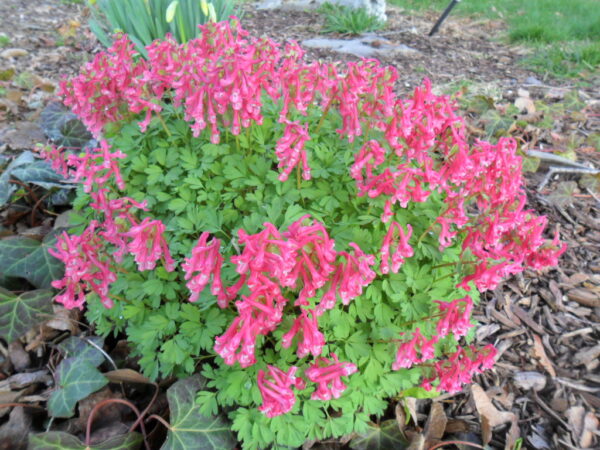
The earliest non-bulb bloomer I have in my garden is a sort of ephemeral, corydalis Beth Evans, which forms a bushy clump of ferny foliage, profuse with bright coral bugle-shaped blossoms, often in flower for me by late February, along with crocus and snowdrops. It’s quite a showstopper to see something so herbaceous and “alive” at that time of year, and guests never fail to remark upon the novelty. I’ve had a pair of these for three years now, and they have proven their worth, so I’ll be investing in half a dozen more come the autumn (there’s also a variety in purple I’m itching to try). Now, post-Beltane, they are already yellowed and dying back, but in their heyday they lend a very welcome and unexpected color and texture to the early Spring garden.
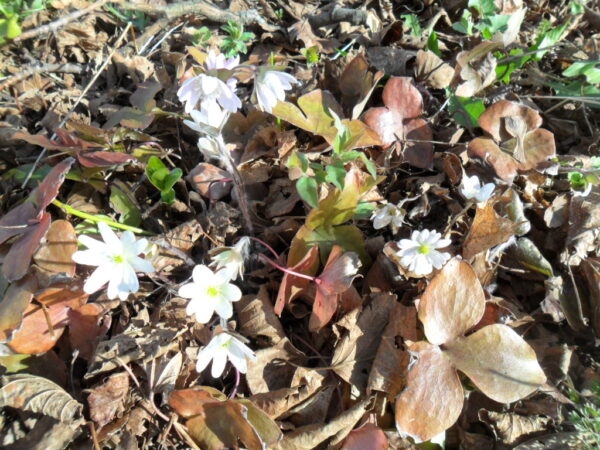
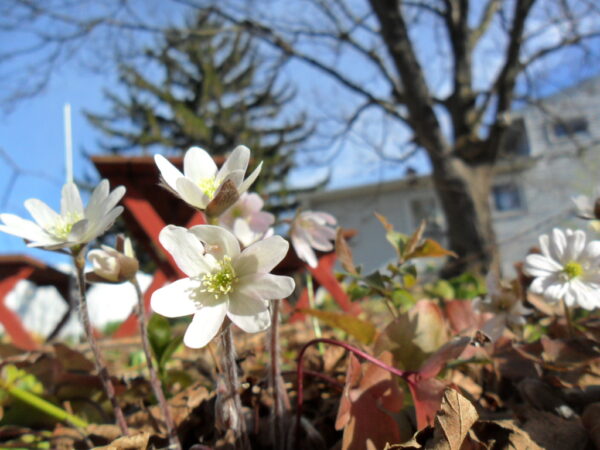
Next to bloom would be my hepatica acutiloba, AKA the sharp-leafed liverwort. This beautiful small-blossomed wonder keeps pace with the earliest daffodils, usually at peak here in early to mid-March. Its starlike blooms come in shades from white to palest pink or lavender; mine are a brilliant white. I had two patches of these originally, and what we’ll call “Patch A” always overperformed compared to “Patch B.” But last year, A was a no-show, and B came streaking to the fore. This year I noted a small resurgence from A; hopefully it will fill in again over time, after its year AWOL. Technically, liverwort isn’t a true ephemeral either, as its liver-spotted leaves continue throughout the season, but its habit of blooming well before those leaves have fully emerged gives it that “fleeting” feel.

For true Spring ephemerals, we turn to the likes of trilliums, stylophorum (celandine poppies), mertensia (Virginia bluebells), dicentra (bleeding heart), podophyllum (May apple), and arisaema (Jack-in-the-Pulpit). These lovelies adorn the late April and May garden with their drama, whether that be of form, like the hooded Jacks and the umbrellaed May apples, or color, like blisteringly bright yellow celandines, sky blue mertensia or deep blood-red trilliums.
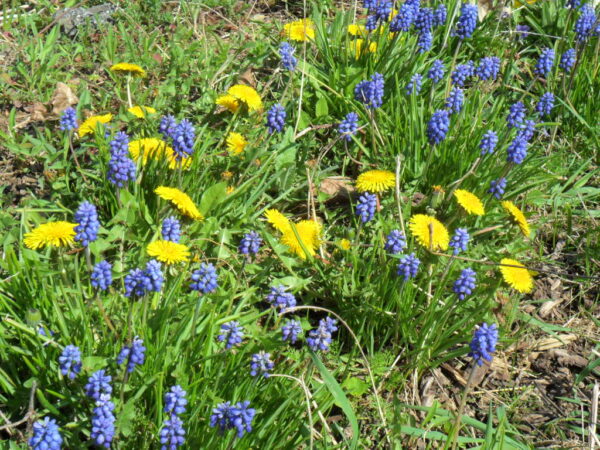
Solomon’s Seal and hardy geraniums bloom now, too, but their foliage persists throughout the growing season, so they’re not in the same class. And later-blooming bulbs, such as the host of muscari (AKA bluebells, though not all are blue) and hyacinthoides hispanica (Spanish bluebells, a much taller cousin) add a zestful accompaniment. Not to be outdone, natives like violets, ground ivy and the ubiquitous dandelion populate the garden widely, increasing year to year.
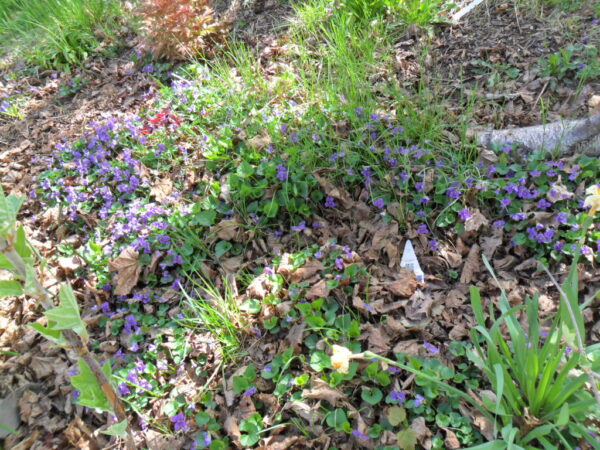
Most of my ephemerals came four years ago, from a grower in West Virginia, who shipped me extremely small bareroot plants at a discount. The price was right, the size was not. All got off to a very slow start; some (like the elusive native dogtooth violets, which I never can seem to establish on the property) never sprouted at all. It’s been a series of triumphs and tragedies, but now, four years on, we’re beginning to get up some steam, and things are looking more encouraging.
Mertensia virginica is a case in point, the elegant Virginia bluebell. I received sets of ten bareroot stock for all my ephemerals, which I divided into groups of five, trying different locations in the shade garden, to see which did best where. The Virginia bluebells have been very slow off the mark in both chosen locations, but this season they performed, what I would call, “adequately,” for the first time. They are a stunning addition to the mid-Spring palette, their red-lavender buds opening into dramatic bugle-shaped flowers of pure azure, on lofty nodding stems. Both patches bloomed moderately this year, despite a very heavy late freeze which threatened to overwhelm them, and I feel confident they’re finally going to start to fill in.

My experience of trillium has been galling, to say the least. I recall drifts of these in the springtime woodlands of my youth, as I trailed after my father on trout-fishing expeditions, more intent on the flora than the fauna. I was so excited to have them in my garden, but the reality has been less than thrilling. Up to now, anyway.
Having no idea what the native varieties were called, I opted for two placeholders for the native plants in my memory, trillium luteum, and trillium recurvatum. Luteum performed the best, sending sturdy spikes encased by a frill of mottled spear-shaped foliage crowned with a yellow blossom that almost resembles a closed tulip, but with gaps between the petals. Great on paper, right? But there’s yellow, and then there’s yellow, as I quickly found. My luteum, while technically of that color, is rather paler than I’d expected and hoped, at times appearing barely brighter than the leaves. Nevertheless, both patches started blooming in their second year, and by now have become moderately established.
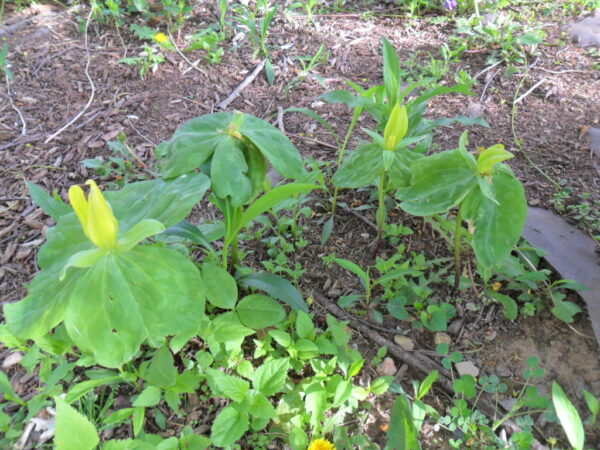
Not so for trillium recurvatum, a withholding fatherless child of a plant which refused to give me more than a few miserly leaves for four years. I had been especially keen on seeing its dried-blood redness, so similar to what I recalled from those long-gone days, and its stubborn recalcitrance of bloom was quite exasperating. I’d pretty much given up on them – one patch, indeed, was so minuscule as to appear to have vanished; but then, just a week or so ago, this worm miraculously turned!
I was out weeding the shade garden when a stray pop of color caught my eye. There, rising in the midst of the sea of blooming woodruff, was a single red trillium! Proud, erect, vividly red-brown, it stood like a lighthouse beacon in that whitecapped green ocean. And this was in the patch I’d given up for lost! Regrettably, the “better” patch is still flowerless, but this single blossom has given me renewed hope that there is, in fact, light at the end of the trillium tunnel, long and curving though it may be.
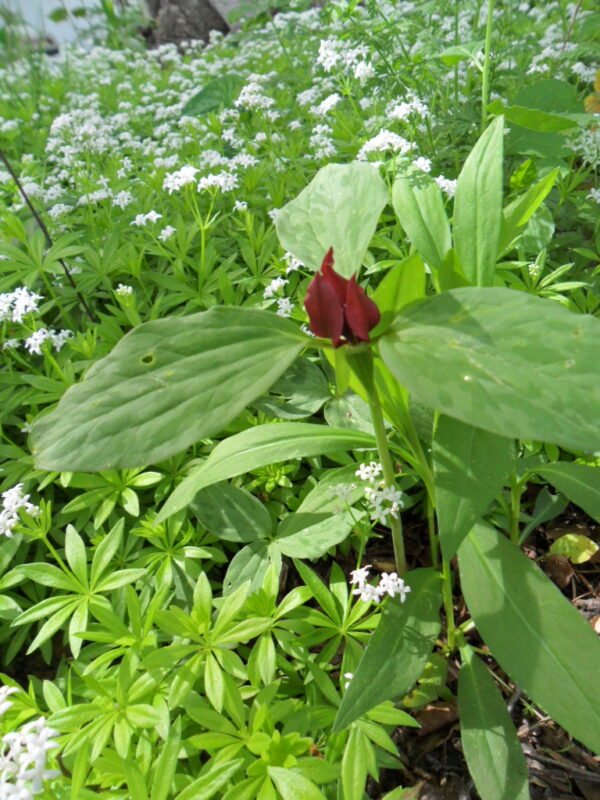
As aggravating as my trillium experience has been, it pales in comparison to the bad luck I’ve had with arisaema, Jack-in-the-Pulpit. These bizarre woodland staples simply refuse to accommodate me, and I suspect the dry shade under the birch is the reason. Though I do strive to keep its underplantings watered, birches are heavy, shallow feeders, and suck up everything I put beneath them. Jacks like it moist, and I just can’t provide enough water here. The smallness of the plants meant I got only leaves that first year, until they matured. The next two years I had some moderate bloom, but this year, just one is left. I expect that, too, will be gone by next spring.
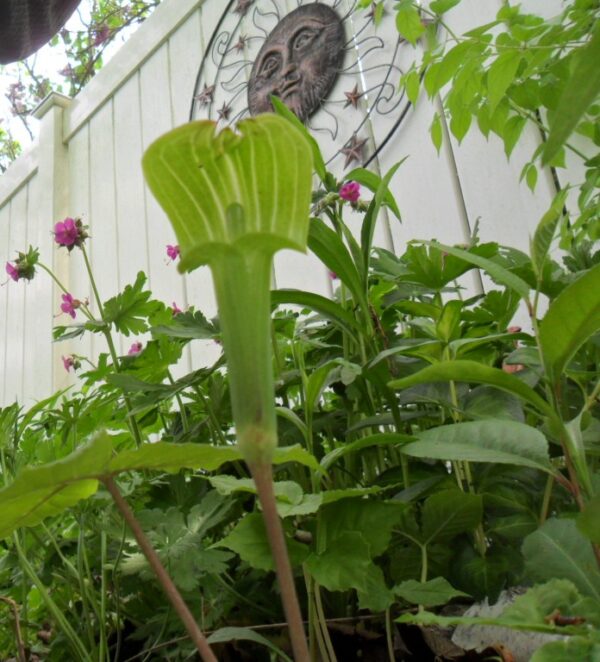
I can’t complain about the podophyllum, however! May apples are another of those plants that evoke childhood for me, seeing vast colonies of them as I scrambled through the woods of Nazareth Park, which abutted on my grandparents’ property. “Exotic” is the word for them, with broad umbrellas of mottled, deeply incised canopies, a pretty white flower resembling a rambling rose, and a yellow-green apple-like fruit that gives the plant its name. May apple fruits are edible, but poisonous before ripening, as is the rest of the plant. I’m not desperate enough to take the chance, though I understand a jelly made from them is quite palatable.
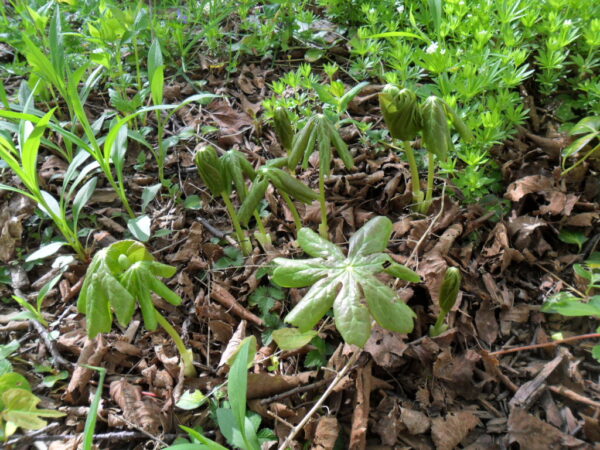
My May apples have performed the best of any of those spring ephemerals I acquired four years ago, with all ten sprouting that first season, and slow but steady expansion ever since. But they have never bloomed. Until now!
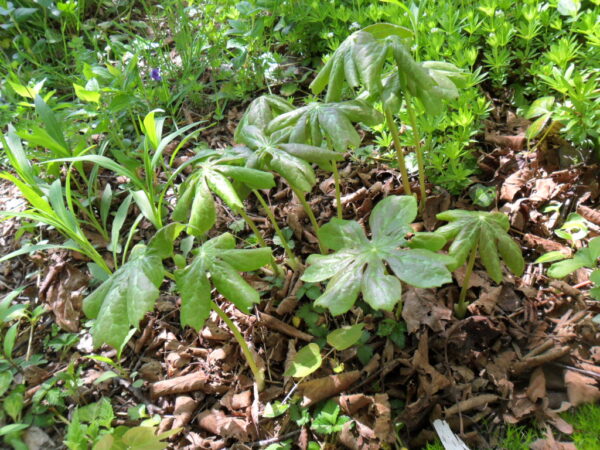
I was bowled over to see the first bud last week, a queer little bulbous protuberance. At first I feared it might actually be the fruit, that I’d missed the flower entirely. But a bit of googling showed me that, like female squash blossoms, the future fruit appears first, as an ovary, followed by the blossom at its tip; if fertilized, the fruit will develop over time.
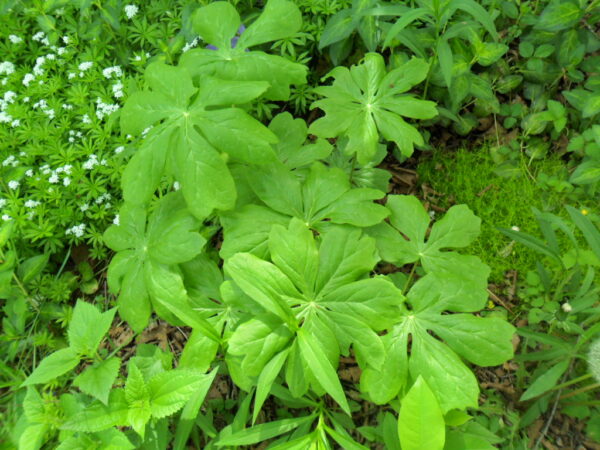
May apple flowers are very attractive, but hard to view. They tend to bud high up the stem, just under the canopy, and are downturned, so they “hide” from prying eyes. For me, though I will crawl over broken glass to get a shot of them in due course, the flower isn’t so much worthy for itself, but rather as a sign that the patch is maturing, and what had seemed like a series of closely planted, but distinct, members is forming a colony, like the ones I recall from my youth. May apple foliage persists well into summer, but by August little remains.
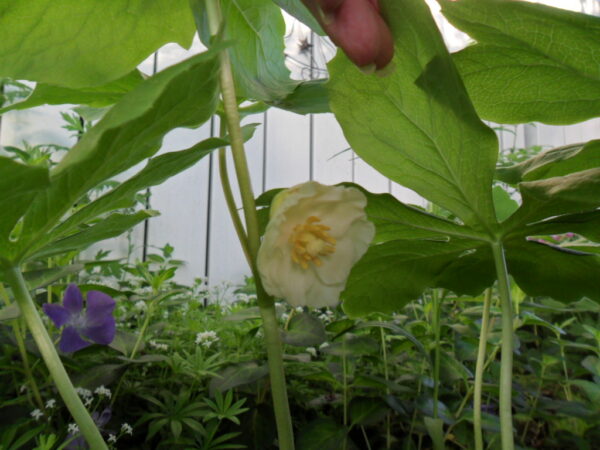
Stylophorum, the celandine poppy, is such a burst of springtime sun as to make even the hardest heart melt! You’ve heard of buttercup yellow? Well, it hasn’t got a patch on celandine! I inadvertently planted both clumps too close together (hey, you try to manage 100 seedings at once!), so they’re near neighbors, somewhat mitigating the idea of spreading things out to test for best conditions.

These have been moderate successes. Blooming their first season, and returning in successive years, they do fine, but nothing outstanding. Last year they began to develop some small “babies” from dropped seed (like other poppies, these are tiny, dark and come in pods), and I swore I’d move them to increase the yield, but life (and my health) intervened, and I never did get to them before the drought of the late spring killed them off. I see fewer young emerging this year, but I am determined to get these moved in time, just as soon as their elders have finished blooming. Celandine flowering can last for weeks, but heat speeds them on, and a couple bursts of summerlike temps in April provoked a truncated season for them this year, lasting just a few days at peak, though stragglers will continue to open for awhile.
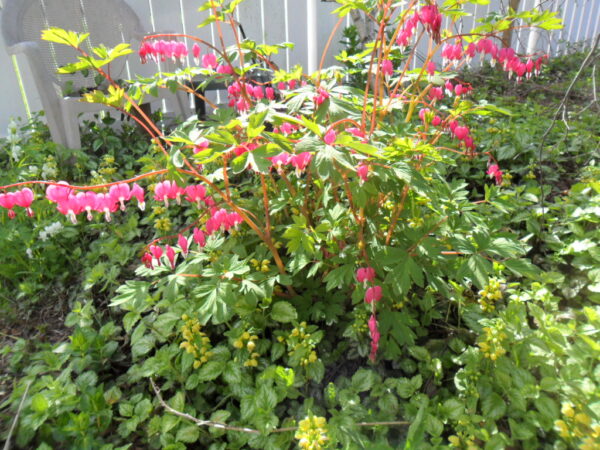
Dicentra, that cottage garden staple known as bleeding heart, is another plant with which I have a very long history. My grandmother had a huge mass of these at the edge of her vegetable garden, and my mother brought a division of that to her new home here. That scion unfortunately failed in a few years, but I have cultivated bleeding heart at every garden I’ve had since the 1980s, even if just potted.
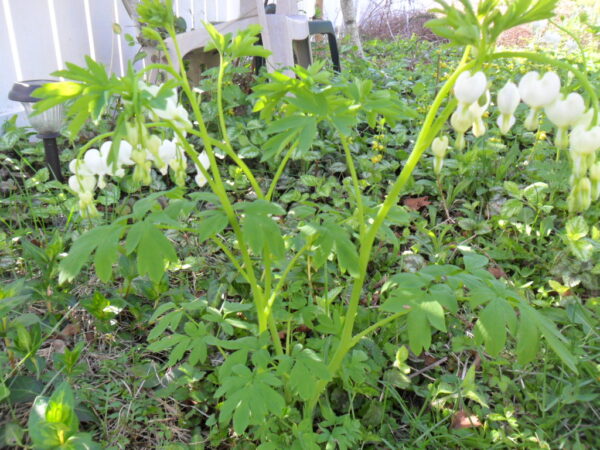
Of course, the pink variety is a classic, but dicentra comes in other colors, from white to purplish-red, and some are available with golden-green foliage as well. I have a special fondness for dicentra alba, the white-flowering cultivar, which is not reciprocated. It does OK for me, but never really reaches the proportions of its elder cousin. Nevertheless, slow and steady wins the race, and at least mine return reliably in this location, which has not always been the case. Bleeding heart generally blooms in May, and by high summer even its foliage is just a distant memory.
Polygonatum biflorum, AKA Solomon’s seal, though not a Spring ephemeral, has been another standout performer of the early growing season, with its graceful arching stems punctuated by paired spear-shaped foliage and dueted tiny white bell-shaped blossoms rimmed in green. My cultivar has the bonus of having striated leaves variegated in green and pale yellow. I bought this plant mature from the now-defunct Point Phillips Perennials, once a major source of material for my garden, and it hit the ground running! What was initially a medium-sized clump has spread into a full-fledged colony, in just three years. After PPP closed, I was kicking myself for not buying another, but this year Solomon’s seal has rewarded me with some offshoot sprouts almost a foot from the parent plant, which I can easily divide to start a second colony.
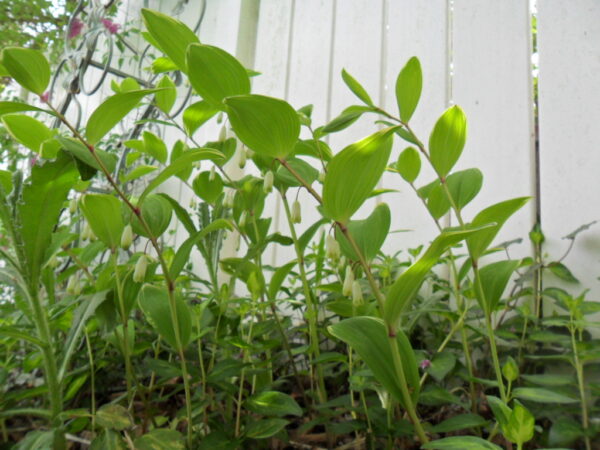
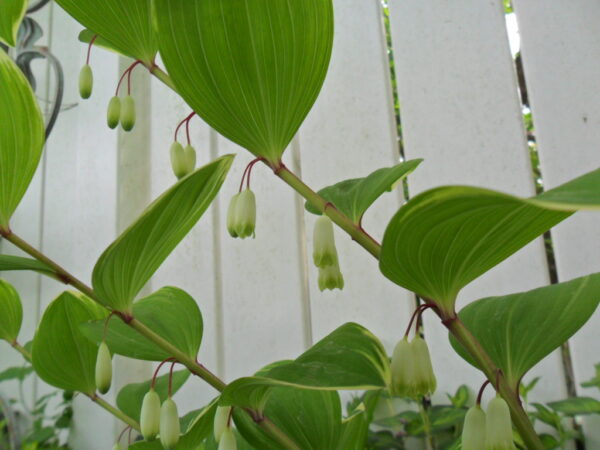
I have three or four varieties of hardy geraniums in the shade garden, the names of which I no longer recall. In shades from bright pink to sky blue, some with reddish or bicolored purple-green foliage, they return reliably, growing larger each season, and have even begun seeding themselves to spread across the space. Geraniums take weeks to bloom out fully, helpfully bridging the gap between spring and summer bloomers, and their foliage persists throughout the growing season. In fact, my initial purchase, also from PPP, was billed as having brilliant red fall foliage, but that’s never been put to the test, because from the day I got it, three years ago, it has remained evergreen! Snow, sleet, frost and freeze, nothing fazes this plant! Truth to tell, I rather wish it would die back, I’d love to have the red color to augment the garden in autumn. Sometimes it will tantalize me with a leaf or two in brilliant red-orange come late October, but in the main, green is the name of the game.
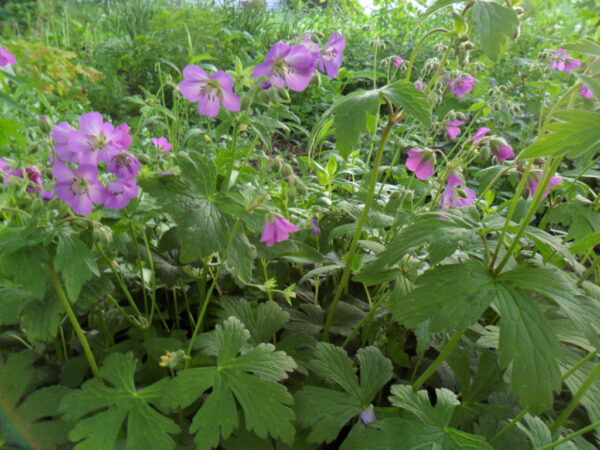
I mentioned that late bulbs in the hyacinth class are also at peak as May Day approaches. These include muscari, everyone’s favorite bluebell, though being the adventurous, easily bored soul that I am, I’ve indulged in many other colors of this attractive, low bloomer.

I invested in white, pink, pale blue, and tricolor versions during my first two major fall bulb installations here, in 2019 and 2020, as well as the standard bright blue. The purportedly rosy Pink Sunrise was pink more in name and concept than in reality, so I’m not overly mourning their loss. They petered out after just a season or two; I still get leaves on one clump, but no more than 3 or 4 minuscule blooms, barely distinguishable from cream.
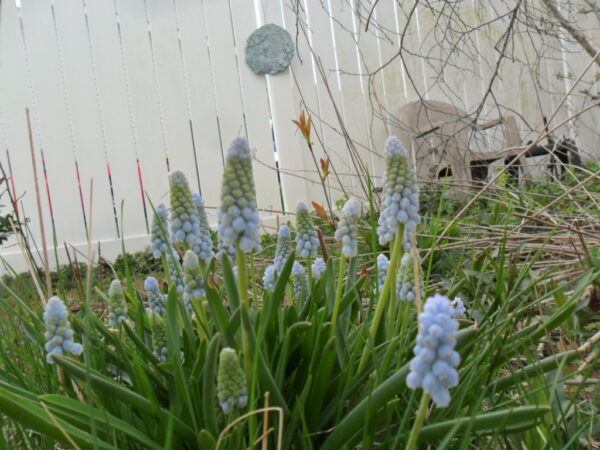
Similarly, the white variety, Siberian Tiger, has its ups and downs. One patch is thriving, the other struggles. The pale blue, named Valerine Finnis, has done the best, and its clusters now provide up to two dozen blooms each. But my favorite is the amazing tricolor version, Ocean Magic. Deep blue at the base, pale blue amidships, and white at the crest, these unique flowers are another conversation-starter in the garden. They do tolerably well, slow to spread, but with observable increase year to year.
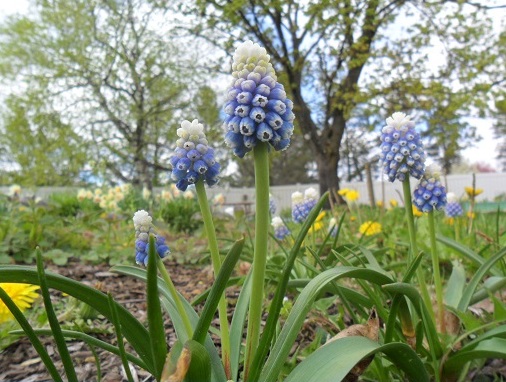
Of course the classic blue is everywhere, self-sowing readily and with numerous stands of heirlooms inherited from my parents. An area that used to be a solitary rectangular bed in the shady area of the lawn (but is now just part of the greater garden), sporting daffodils, bluebells and peonies in succession, has become overrun with bluebells in a very natural setting.
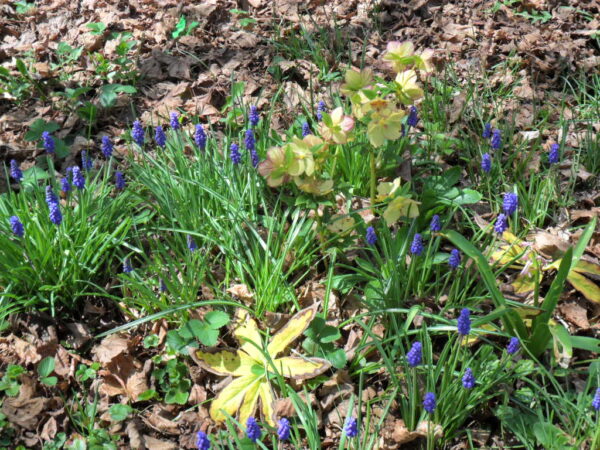
The only real competition they have, since the daffs and peonies were both moved to give them better light, is the violets (and the occasional hellebore I interpolated in the last few years). Bluebells dominate about half the old bed, and what I call my “violet ramble” dominates the rest.
Violets, apart from being one of the more lovely and reliable perennial natives, are among nature’s wonders, actually improving conditions wherever they grow, by helping to fix nitrogen into the soil. They are prolific self-sowers and spread rapidly, to the point where now I have them literally everywhere across the landscape. And I don’t mind their ubiquity one bit! As well, their heart-shaped foliage is attractive throughout the growing season, the blooms are long-lived, and surprisingly long-stemmed for such a low-growing plant, affording fodder for sweet diminutive indoor bouquets for weeks.
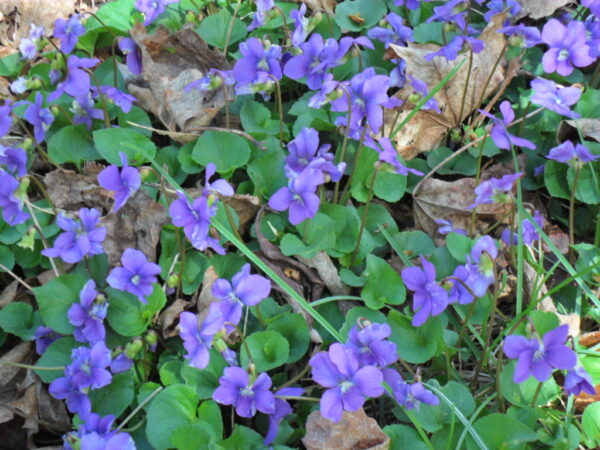
Occasionally I find a mutation in the yard, a purple violet that has turned mostly white, and whenever I do so, I transplant it to a small patch I’m developing at the path’s border. That colony is doing very well, and blooms a bit earlier than its traditional forebear.
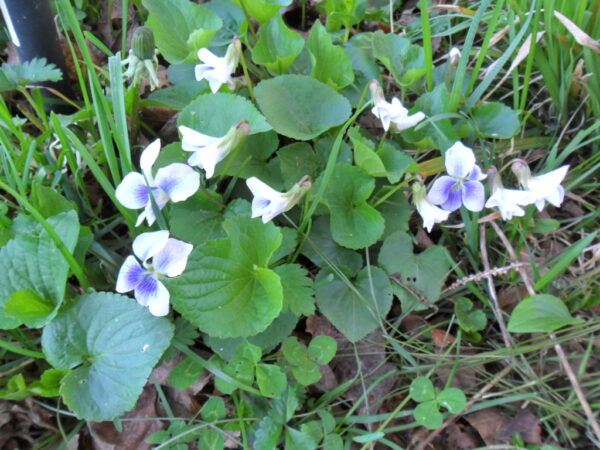
Another late-blooming hyacinth-class bulb is hyacinthoides hispanica, the Spanish bluebell, which towers over other varieties, extending up to two feet in height. The bell-shaped flowers have more “edge” than standard bluebells, quite literally, with sharp-looking recurved petals in a much larger scale. Spanish bluebells come in white, blue and pink versions, and there’s no mistaking their pink for another color! It’s a lovely medium shade, bright and eye-catching, and planted in groups with the other colors, makes a bold statement in the mid-May garden.
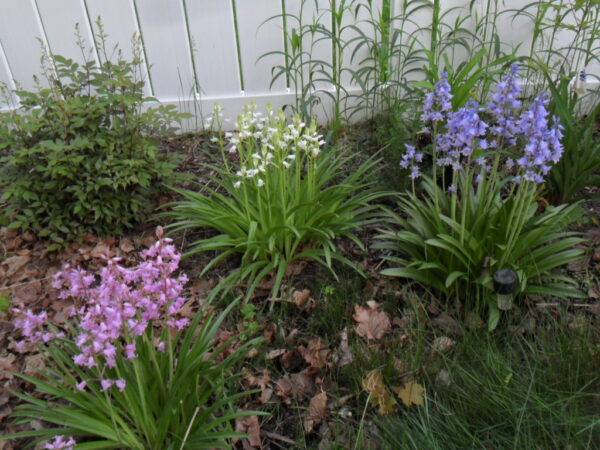
A number of ground covers bloom at this time as well, including ground ivy, vinca, mazus reptans, sweet woodruff and archangel. Ground ivy is a weed, no doubt about it, and an invasive one at that! But it’s so lovely in bloom that I barely mind. Starting in March, and blooming for up to two months, ground ivy sends low 3-4” spires of ruffled-leaved stems festooned with encircling tiny purple blooms, much like the mint to which it is related. An important early food source for pollinators, ground ivy is often still in bloom when archangel takes sway.
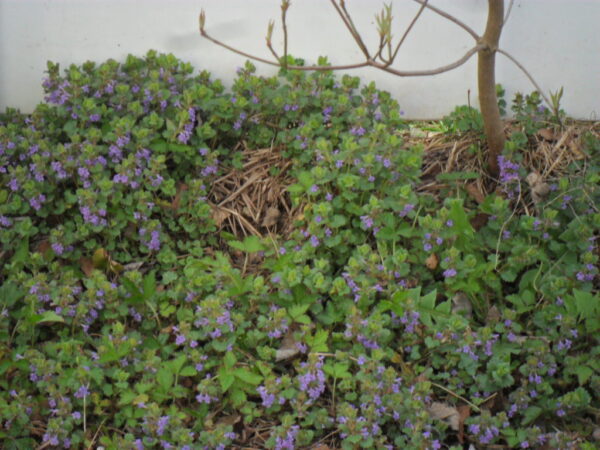
A mint relative also, archangel’s variegated silver and green foliage is a standout stunner all season long, but in April it rewards the impatient gardener, sick of its invasiveness, with 8-10” tall spikes of intensely bright yellow blooms which, like ground ivy, encircle the top two-thirds of the stem in rows. The two together put on quite a show!

Vinca is another highly invasive plant, which was my ally once, when I had a large area of bare earth to cover. But our alliance is wearing thin now that it’s been given its head for four years. I have two versions: deep green and green mixed with gold, and these have taken over vast amounts of space, requiring some serious editing on my part. But not just yet – in April and May these are dotted with lovely blossoms in periwinkle blue, and I’ll wait for that show to wind down before I bring out the shears.
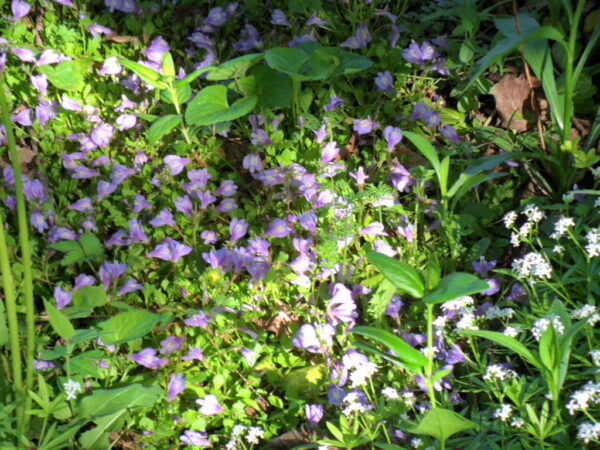
Mazus reptans is about as low a ground cover as you can get, barely rising above the soil, but its height-challenged density means that very little else will find a foothold beneath it, and it keeps down weeds like nobody’s business. It has an attractive, spoon-shaped foliage in miniature, and will tolerate some foot traffic. The glory of mazus, however, is its bloom. In May the plant is so covered in tiny purple blooms as to make the foliage almost invisible. These diminutive beauties have a somewhat orchid-like appearance, and brighten landscapes from full sun to partial shade for weeks.
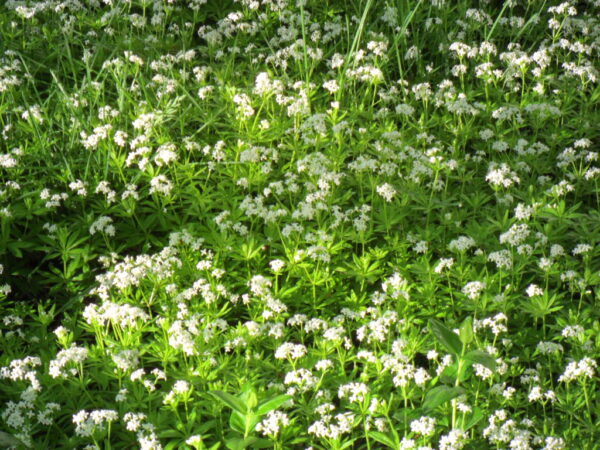
But it’s my woodruff of which I am proudest. I’ve loved woodruff (galium odoratum for the botanically-minded) since I first encountered it in my twenties, and like bleeding heart and archangel, it has come along for the ride whenever I’ve moved residences. About 5-6 inches tall, woodruff is an avid spreader and forms a dense carpet of chartreuse-green that keeps most other weeds down. It prefers some shade, and the dappled light under the birch is the perfect environment for it here.
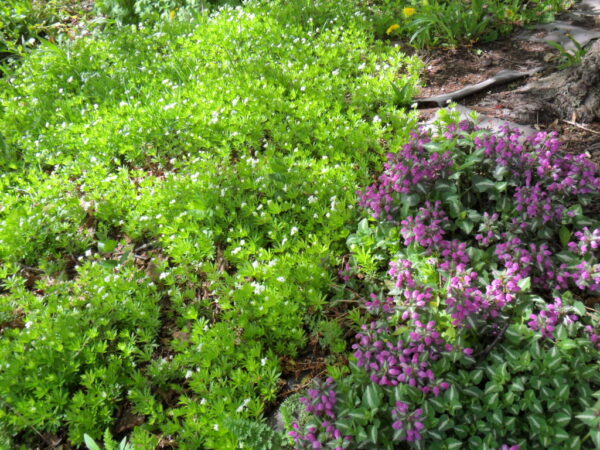
I started with four 6” pots that first year, added two the next, and by now those tiny rounds of green have become vast lagoons yards across in some cases. Woodruff blooms in late April to mid-May, sending delicately branched stalks of snow-white miniscule star-shaped blossoms skyward. These rise about two more inches above the foliage, and the effect is lovely indeed, as well as long-lasting. It has a connection to Wicca and paganism, with sprigs often added to a Beltane punch. Woodruff can also be used in arrangements, and pairs beautifully with violets and my lemon-green euphorbia.
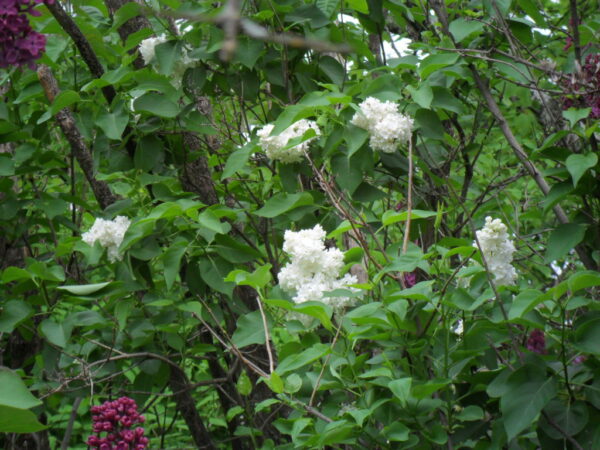

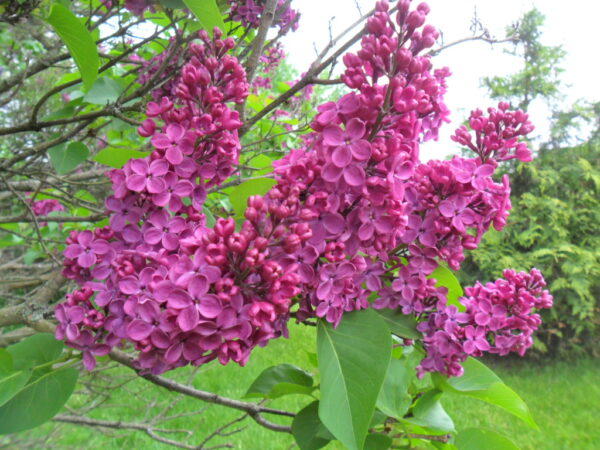
I’d be remiss in this review of Beltane timeframe florals if I didn’t give a tip of the hat to lilacs, despite their status as long-lived woody perennial shrubs, which hardly fits my theme. I’ve been blessed with numerous lilacs, all well-established heirlooms which have been on the property for up to sixty years. I have no fear of loss, though – lilacs often pass their centennial, so there’s lots of life left in these antiques yet.

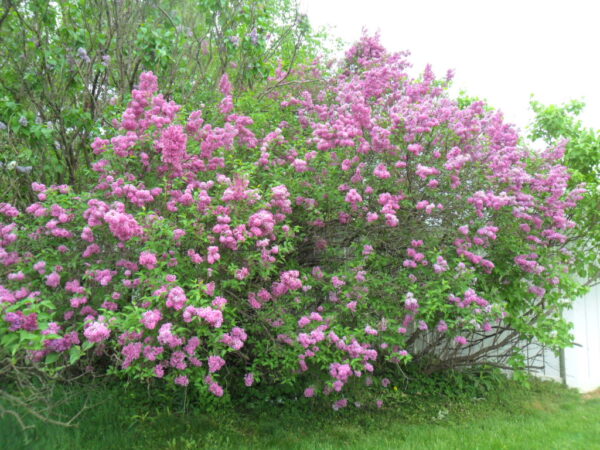
While I have pinky-lavender, frilly French lilacs, single- and double-flowered white Persian lilacs, and medium-purple double Persians, my favorite is the deep red-purple Persian variety. There is nothing else in nature like its trademark color: red, burgundy and violet all at once. A scion of a stand on my grandfather’s property, this has been with us the longest, and now towers well over twenty feet. But it still blooms low enough to enable cuttings for lavish bouquets that spill out over the brown glazed ceramic pitcher-style vase that my mother always used to display them. Continuity like that becomes even more important to me as I age, and the people and places I knew as a child are gone or irrevocably changed.
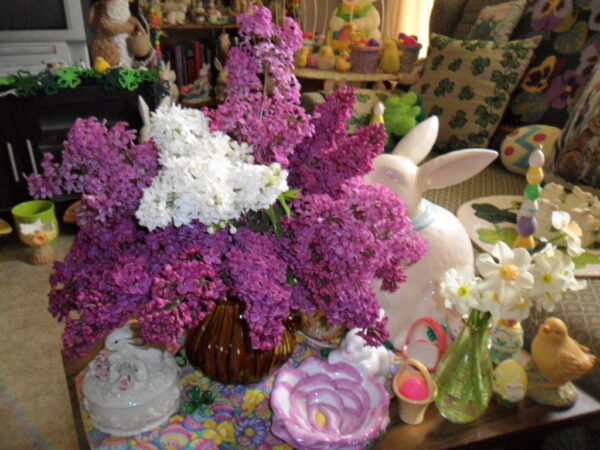
Ephemeral they may be, but the flowers of April and May continue to dazzle the eye and gladden the heart, as they reach ascendance in the ever-turning wheel of the year.
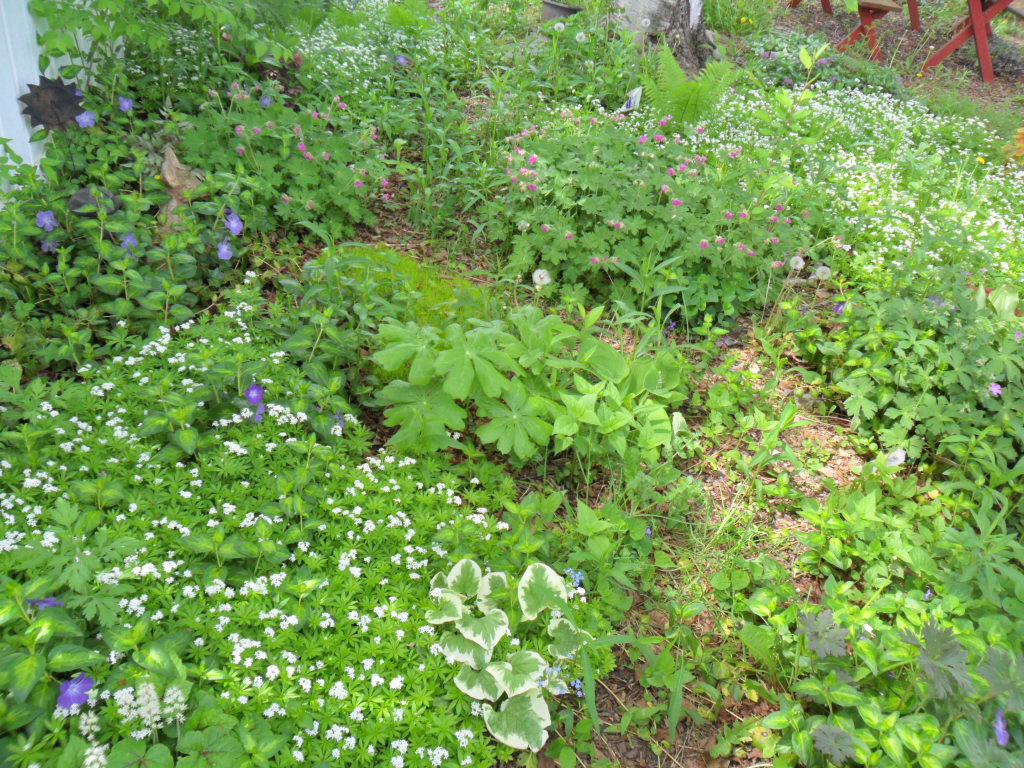

3 comments, add yours.
Irmgard Dering
Your garden photos always make my day! They are magnificent!
Laurien
I really enjoyed this, Alex, especially learning about plants I’ve never heard of like May apple and mazus reptans! The red trillium is magnificent and I agree that the red-purple Persian lilac is also stunning. Keep up the good work! Thanks for sharing!
Rosemary
Thank you for allowing us to see your flower garden. I loved learning about
the different kinds of wild flowers. I live in Florida now, but growing up
in Missouri, we had lilacs, violets & daffodils. Forsythia, red bud, spirea
or ‘bridal wreath’, wisteria and lily of the valley. And a lavender (fragrant)
flower that grew wild in the woods, called ‘sweet william’.
‘Shakespeare wrote: ‘I know a bank where the wild thyme blows and
oxlips and the nodding violet grows’.
i